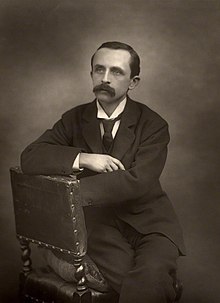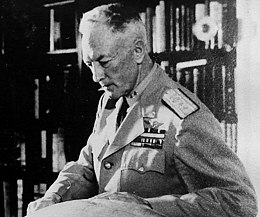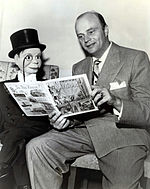 |
| Sir James M. Barrie |
J. M. Barrie Born, 1860
James Matthew Barrie was the author of numerous novels and plays, but the world remembers him as the man who wrote Peter Pan. He was the ninth child of ten born to a Scottish weaver and his wife, and his childhood was marred by a tragic incident that would forever leave its mark on him. When he was six, his next-older brother, David, died in an ice-skating accident, just a few days before his 14th birthday. David was his mother's favorite child, and James tried to fill the void. He dressed in David's clothes, and learned to whistle in the manner David had. His mother was said to have taken comfort in the idea that David would never grow up, and would remain a boy forever.As a young man, Barrie wanted to become an author but his parents insisted that he study for the ministry, because that's what David would have done if he had lived. Barrie eventually reached a compromise with them: he would go to the University of Edinburgh, but he would study literature, rather than the ministry.
Probably the most important relationships in Barrie's life were with the members of the Davies family. George and Jack Davies, accompanied by their nanny and their baby brother Peter, had met Barrie while he was walking his St. Bernard, Porthos, in Kensington Gardens. The children were vastly entertained by Barrie's stories, and by his ability to wiggle his ears and his eyebrows. Later on he became close to the entire family: parents Arthur and Sylvia, and sons George, Jack, Peter, Michael, and Nicholas. Peter Pan had its beginning in the stories he told to the children.
 |
| The boys' mother, Sylvia Llewelyn Davies |
Among Barrie's friends and acquaintances were many stars of the literary world, including George Meredith, George Bernard Shaw, H. G. Wells, Thomas Hardy, Arthur Conan Doyle, G. K. Chesterton, A. A. Milne, and P. G. Wodehouse. He never met Robert Louis Stevenson (who was in Samoa at the time), but he corresponded with him for many years. He was also a friend of Robert Falcon Scott, and was one of the seven people to whom Scott wrote letters just before his death on his doomed Antarctic expedition. The two young daughters of the Duke of York -- the future Queen Elizabeth II and Princess Margaret -- were also entertained by his stories.
 |
| The Davies boys with their father: Baby Nico, Michael (in front) and Jack, Peter, and George |
 |
| Admiral Byrd in 1955 |
Byrd Flies Over the North Pole, 1926
Or did he?Admiral Richard E. Byrd claimed to have been the first person to fly over both the North and the South Poles. The claim about the South Pole is generally accepted. We're not so sure about the North.
The plane was a Fokker F-VII named the Josephine Ford and Byrd's pilot was Floyd Bennett. They left from and returned to Spitsbergen, Norway. Almost immediately there was controversy. The European press didn't think that they had been gone long enough to reach the Pole and return. In the United States, however, both men were heroes. In fact, they were awarded the Medal of Honor for their supposed feat.
 |
| The Josephine Ford in flight |
But then again, there are various individuals who claim that either Byrd or Bennett or both acknowledged to them, privately, that they did not complete the trip.
Thomas Blood Steals the Crown Jewels, 1671
Thomas Blood was quite a fellow. He fought for Charles I, he fought for Cromwell, and he tried to kidnap the Duke of Ormond -- twice. In 1671, he decided to steal the Crown Jewels, and came up with quite an ingenious plan. If the jewel-keeper's son hadn't unexpectedly come home from military service, he might have gotten away with it. You can read the whole story, "Thomas Blood and the Crown Jewel Caper", here. |
| Charlie and Bergen in 1947 |
Charlie McCarthy and Edgar Bergen Get Their Own Show, 1937
It seems incredible that a ventriloquist act could be a bit hit on the radio, but Edgar Bergen and Charlie McCarthy were just that. They had already been successful in vaudeville, of course, and the previous December they had been a big hit on Rudy Vallee's Royal Gelatin Hour. On May 9, 1937, they debuted their own show, a segment of The Chase and Sanborn Hour. They remained on the air until 1956.Edgar Bergen was not known for being a particularly good ventriloquist. Even Charlie McCarthy noted that he moved his lips. His real talent was in the creation of Charlie's character -- and that of his other characters, such as Mortimer Snerd and Effie Klinker -- and his skills in comedy.
Edgar and Charlie played a significant part in the War of the Worlds panic of 1938. When Orson Welles aired his dramatization of the H. G. Wells novel on October 30, many listeners missed the beginning of the broadcast (when the first statement that this was a fictional program was made) because they were listening to The Chase and Sanborn Hour on another station. When the Edgar Bergen segment was over, they switched stations. Tuning into The War of the Worlds at about the 12-minute mark, they believed they were listening to real newscasts of an alien invasion.
 |
| Mortimer Snerd was another favorite. |
Three copies of Charlie McCarthy were made for Bergen and still exist today. One is in the Smithsonian Institution. Another is at the Museum of Broadcast Communications, Chicago. The third was purchased at auction by magician David Copperfield for $110,000.
Candice Bergen Born, 1946
It seems appropriate that today is also the birthday of Charlie McCarthy's "sister", Candice Bergen. (Actually, as a young child, she disliked being referred to as Charlie's sister.) She first appeared on radio on her father's show at the age of six. At the age of 11, she appeared on Groucho Marx's You Bet Your Life, and even sang with him.Bergen's film debut was as the patrician lesbian character in The Group in 1966. Other notable films include The Sand Pebbles, The Wind and the Lion, Carnal Knowledge, Gandhi, and Starting Over.
On television, she received seven Emmy nominations and five wins for her starring role in Murphy Brown. (After the fifth win she declined to be nominated any more.) She also received Emmy nominations for her supporting role in Boston Legal.
No comments:
Post a Comment